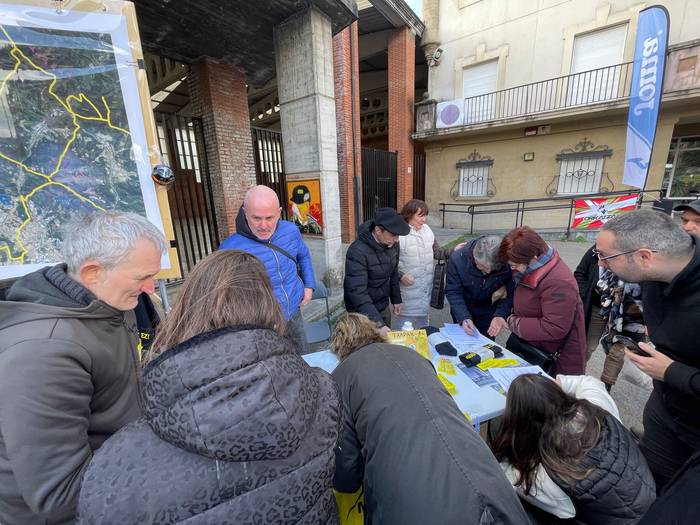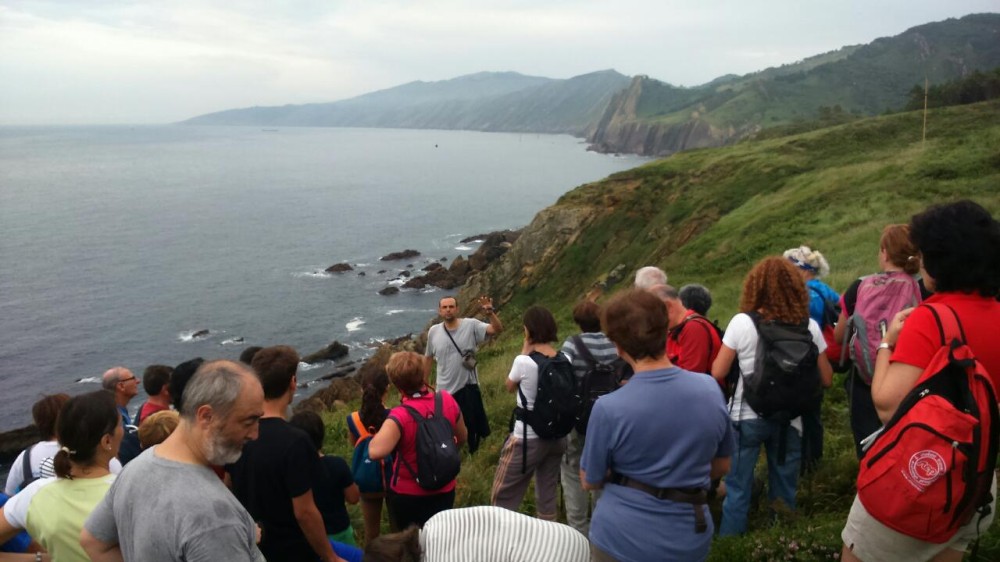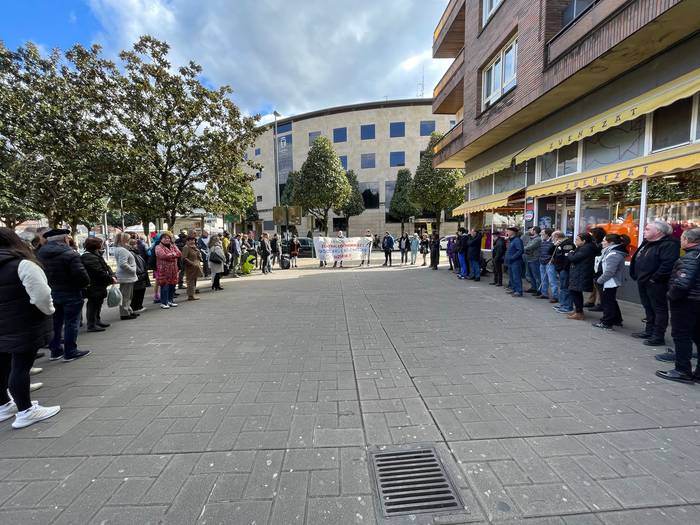Terror in the zero kilometer of the TAV
- On January 17, 2009, the small Alavese council of Urbina became a shooting ground. The Ertzaintza was forcefully launched against protesters against the TAV, which tried to leave dozens of people injured and many others in the hands of the Spanish National Audience. The chapter on criminalisation of civil disobedience will forever remain in the black book of the Department of the Interior of the Basque Government.
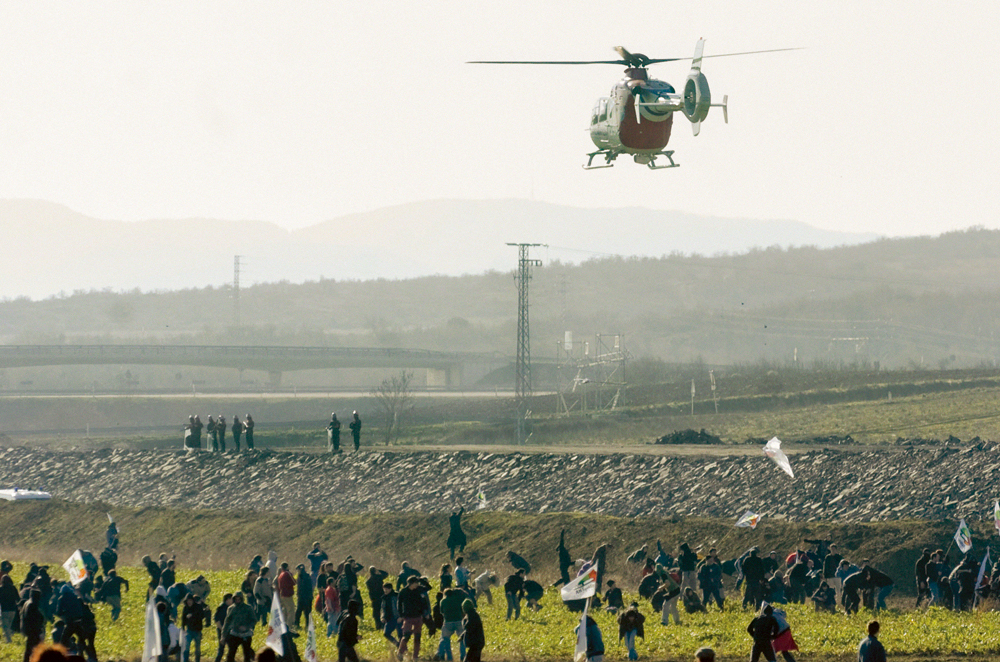
It seemed like a picture taken by Surrealism: A Police helicopter was speeding past the potato fields and people's heads, the Ertzaines with their faces covered ran from one side to the other, with a porch in their hand, following the neighbors up the mountain, if they had been able to hunt, and the constant pace of the pelotazos sounded quickly. Shouting, crying, panting and wounds. If there were no banderolas against the TAV, we would think it was in 1977, the Campo de Arazuri, together with Pamplona, and those who gathered there fleeing police repression at the end of the Freedom March.
But no, it happened in Urbina, in the 21st century. The movement against the High-Speed Train organized a demonstration that day, under the slogan AHT Gelditu! From Elkarlana’s hand, “to prove that the project can be stopped through mobilization”. In response to the call, more than 4,000 people gathered in this Alavese corner, many of them on buses, overcoming the controls of the Civil Guard. The place chosen was not precarious, three years earlier the works of the so-called Basque Y had begun in Urbina and eventually became one of the main outbreaks of protest against it. In a popular consultation, Urbina’s neighbours rejected the “iron carpet”: 109 of the 125 people censored were against it.
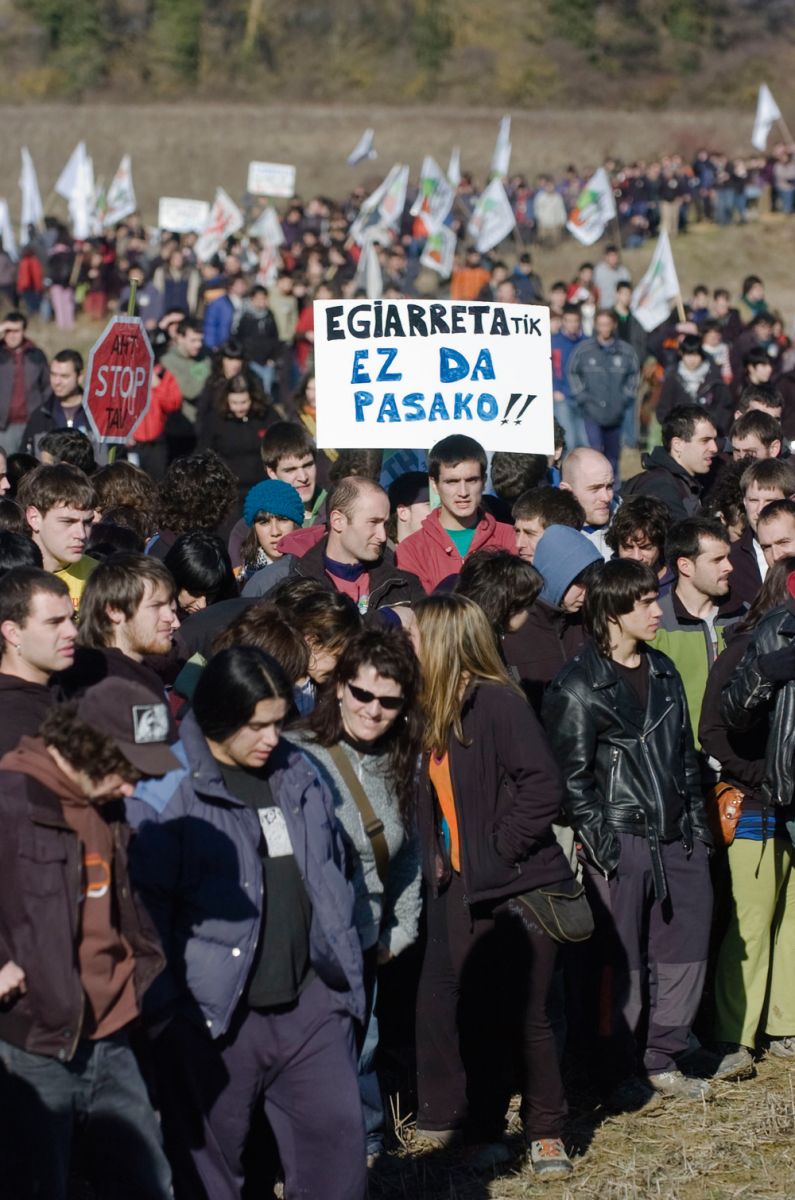
The demonstration departed from the plaza and at the end of the same hundreds of people approached the works between Urbina and Erretana to “occupy”, with a peaceful symbolic sitting, the railroad, which was still only an embankment. The Ertzainas suddenly assaulted the occupants who were lower down in the slope, and once the situation was reassured, they began a three-kilometer chase that many will not forget to the village, hitting, hurting and capturing a lot of people. Eight people were arrested. The word ambushed here is no more.
The silence of some media that are under the control of big business was evident, while the others only published information from the agencies, highlighting the data from the Department of the Interior: that the protesters had thrown stones and that there were six officers injured. On the contrary, AHT Gelditu! On the websites of the coordinator and other free groups and radios the testimonies of the victims of the citizenship have been kept, and we can also see images edited by Eguzki Bideo on Youtube, under the title “Eskuak gora! Hands up!” is heard by a woman’s mouth when people are forced into a tunnel filled with agents. Then the shots. For the social movement not to condition powers in the future, it is necessary to work its history “from within” and for this purpose there are oral sources: “The collective memory materializes in a political space shaped by these subjectivities,” explained historian Laura Benadiba.
“The worst was when we got to the tunnel under the freeway, where more police were waiting for us,” says one of the witnesses. Tired of running, he was thirsty and very nervous because he saw the attitude of the ertzainas (...). It was terrible, people screamed saying that we were no longer in the camp; besides the pores it was loaded with balls and the shots sounded a lot.” Several people were injured by gunshots of balls about two meters high, according to the same sources.
In the town of Urbina there were also unpleasant situations: the Ertzainas entered the councillor house or the Bolera and randomly located several people who were refugees there; they also put the wives to the wounded in the ambulance and recorded one by one those who went on the buses. “I had never seen such brutality. I tried to tell everything quickly, but I did not get into other details – another witness is lamented – beatings people who fall to the ground, curses ... The blows and intimidation I received were no exception.”

Start of criminalisation
The Interior section, led by Javier Balza, tried to bring the eight detainees to the Spanish National Court, but Judge Santiago Pedraz was inhibited saying that “there was no crime of terrorism.” This detail did not go unnoticed and the movement against the TAV denounced the attempt to criminalize: “They wanted to teach a lesson in mass civil disobedience.”
Attempts have long been made in some media to link actions against this infrastructure with ETA threats. In 2008, the armed group murdered the leader of one of the business associations that were building the TAV, Inaxio Uria, in a statement issued on January 21, 2009, in which he assured that he had killed for not paying the revolutionary tax and for his responsibility in the construction of the TAV. After that, they framed all opposition to the railways under a “terrorist strategy”: ecologists were also part of the “civil ETA”. The Basque Government adhered to the theory of bringing the judicial proceedings from Urbina to Madrid.
The mobilizations were as high as possible, a year earlier 15,000 people had gathered in Arrasate against the train tracks
The mobilizations were at their peak at that time. A year earlier, 15,000 people had concentrated in Arrasate against the railways and spectacular concentrations and actions were taking place every day in the villages, now an interrogation, now a protest against the expropriation minutes. But all of this movement didn't come out of nowhere, but had been around for years.
25 years of multi-motion
The Anti-TAV Assembly was established in 1993. By then, the draft outline devised by the engineer José María Elosegi already worked in the offices of various institutions and parties, back and forth. However, the ignorance of the affected municipalities was such that in 1994 the municipalities of Iurreta and Aduna were the first to present arguments to request data. It can be seen in the humorous stickers against the TAV of the 1990s and 2000, that this environmental movement coincided with other long-range anti-developmentalist currents: “Here come the developmentalists to Euzkadi azkatzera” (sic) says one of them, “Pastel Euzkal. We all pay and those who always eat”, the other... Not limited to conservationism, they linked the APR project with a whole system to change.
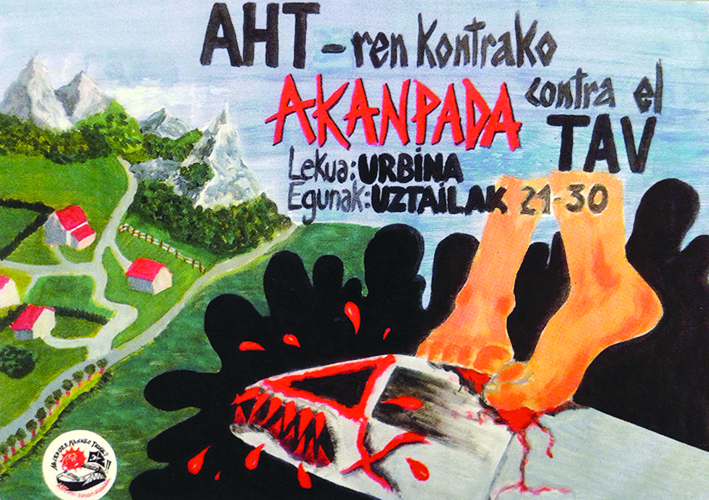 With the beginning of the millennium AHT Gelditu! The creation of the partnership served to maintain minimal coordination, but the movement continued mainly in the counties and towns. In 2004 they presented an alternative to the “social train”, supported by unions such as ELA, LAB and EHNE. This road enabled great concern in AHT Gelditu! between the different groups that were in the coordinator, because the railway – and the one that replaced it – was in contradiction with the idea until then of stopping, yes or no: “One asks what is that nice real you want to do with the TAV,” said one of the members of the Assembly Against the TAV.
With the beginning of the millennium AHT Gelditu! The creation of the partnership served to maintain minimal coordination, but the movement continued mainly in the counties and towns. In 2004 they presented an alternative to the “social train”, supported by unions such as ELA, LAB and EHNE. This road enabled great concern in AHT Gelditu! between the different groups that were in the coordinator, because the railway – and the one that replaced it – was in contradiction with the idea until then of stopping, yes or no: “One asks what is that nice real you want to do with the TAV,” said one of the members of the Assembly Against the TAV.
Urbina, resistance space
The reality, however, became the TAV when the works began in 2006. What was nothing more than an invisible ghost, it was embodied in a real cement and iron – you can read in a sticker “Red Alarm!”, because in Itsasondo they were about to start the polls. The first awards were made by the Ministry of Development between Legutiano and Urbina. AHT Gelditu! met in Legutio to discuss how to respond to the project: “slowing down as much as possible” and thus considered “the ideological struggle” important.
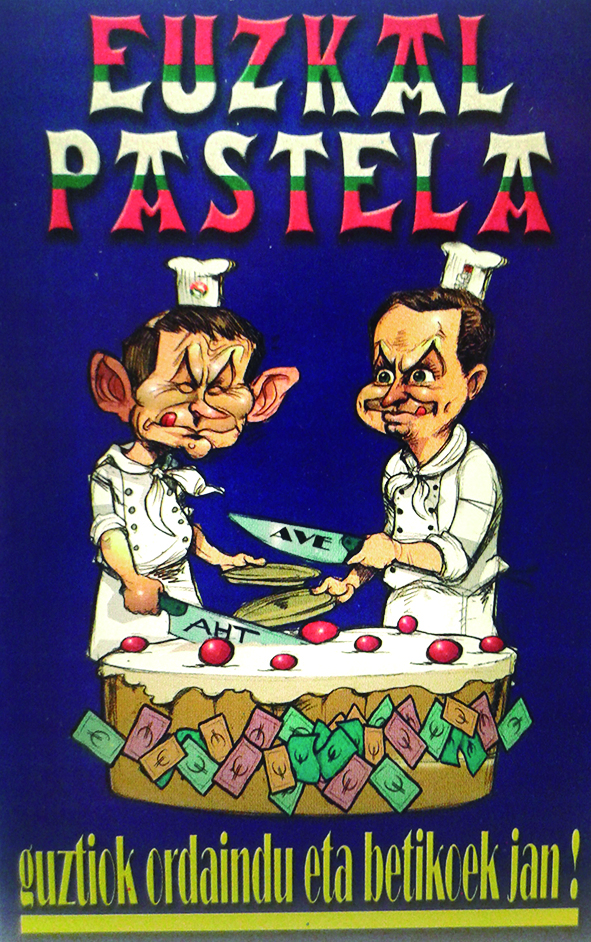 Thus, Urbina became a “resistance centre” against the TAV, and, among other things, several camps were organized in the area. In many places, a call for direct action was opened. “Boycott and sabotage the enemies of Amalurra!” says in one of their stickers the legendary anti-nuclear sun. Indeed, it was possible to slow down the progress of the works, which had barely advanced in three years. However, after the ambush of Urbina, the Y Vasca had a great boost: Eusko Trenbide Sarea awarded 10 of the 17 tranches held between 2009 and 2010.
Thus, Urbina became a “resistance centre” against the TAV, and, among other things, several camps were organized in the area. In many places, a call for direct action was opened. “Boycott and sabotage the enemies of Amalurra!” says in one of their stickers the legendary anti-nuclear sun. Indeed, it was possible to slow down the progress of the works, which had barely advanced in three years. However, after the ambush of Urbina, the Y Vasca had a great boost: Eusko Trenbide Sarea awarded 10 of the 17 tranches held between 2009 and 2010.
Since then, there have been many spectacular protests, such as the concealment of four activists in the mines crossing the TAV in Itsasondo in July 2010 – eight years later they have been tried and fined. Move around! the disobedient movement of the fluorescence tingle to attract the attention of the various rivers. But demobilization was evident in the villages of Álava, Gipuzkoa and Bizkaia where the Basque Y was going to take place – in Navarre since then initiatives against the fast train corridor have been reactivated; and in Lapurdi the project is paralysed. In 2012, the Assembly Against the APR was one of the causes of its dissolution “the frustration generated by local destruction”.
Deactivation of mass movement
The detainees in Urbina were held incommunicado by the Ertzaintza for three days. In many places concentrations were held in order to demand their freedom and to reject the action of the Ertzaintza. The relatives of several detainees also publicly denounced the treatment received at the police station and the lack of information on it.
The establishment of the building managed, through criminalization, not to turn the fight against the TAV into mass movement.
Ten years later, the importance and gravity of the events of Urbina can be measured with a broader vision: the indiscriminate use of rubber balls, the discrepancies of the environmental collectives, the demobilization of the citizen, the acceleration of the railway works by the institutions, making society feel that the TAV was “irreversible”… But, above all, we now know that in those fields of potatoes it did not succeed.
Josu Estarrona EH Bilduko Arabako senatariak egindako galderari erantzun dio Espainiako Sustapen Ministerioak, eta hor berretsi du Ezkioko aukera zailtasunez beteta dagoela.
Festa egiteko musika eta kontzertu eskaintza ez ezik, erakusketak, hitzaldiak, zine eta antzerki ikuskizunak eta zientoka ekintza kultural antolatu dituzte eragile ugarik Martxoaren 8aren bueltarako. Artikulu honetan, bilduma moduan, zokorrak gisa miatuko ditugu Euskal Herriko... [+]
Laudion, Aiaran eta Okondon izango du eragina energia azpiegiturak eta plataformaren aburuz, proiektuak eta ingurumen-inpaktuaren azterketak gabezia garrantzitsuak dituzte.
Andeetako Altiplanoan, qocha deituriko aintzirak sortzen hasi dira inken antzinako teknikak erabilita, aldaketa klimatikoari eta sikateei aurre egiteko. Ura “erein eta uztatzea” esaten diote: ura lurrean infiltratzen da eta horrek bizia ekartzen dio inguruari. Peruko... [+]
Satorralaia plataformak Donostiako Metroaren Mirakontxa-Easo zatiko lanek “%164ko gainkostua” izan dutela salatu zuen joan den astean, eta, horren harira, EH Bilduk gainkostu hori argitzeko eskatu du, Eusko Legebiltzarrean erregistratutako galdera sorta baten bidez.
Agintari gutxik aitortzen dute publikoki, disimulurik eta konplexurik gabe, multinazional kutsatzaileen alde daudela. Nahiago izaten dute enpresa horien aurpegi berdea babestu, “planetaren alde” lan egiten ari direla harro azpimarratu, eta kutsadura eta marroiz... [+]
Mendizale batek asteburuan ikusi du animalia Lapurdiko Azkaine herrian, eta otsoa dela baieztatu du Pirinio Atlantikoetako Prefeturak. ELB lurraldean "harraparien presentziaren kontra" agertu da.
Elkarretaratzea egin zuen Aiaraldeko Mendiak Bizirik plataformak atzo Laudioko Lamuza plazan, Mugagabe Trail Lasterketaren testuinguruan.
Udaberri aurreratua ate joka dabilkigu batean eta bestean, tximeletak eta loreak indarrean dabiltza. Ez dakit onerako edo txarrerako, gure etxean otsailean tximeleta artaldean ikustea baino otsoa ikustea hobea zela esaten baitzen.
Nori ez zaio gustatzen ahuakatea? Ia denok atsegin dugu fruitu berri hori, di-da amaren batean etxekotu zitzaigun. Zenbat urte da ba dendaero ikusten hasi garela? Gure mahaietara iritsi aurretik, historia luzea du.
Gipuzkoako hamaika txokotatik gerturatutako hamarka lagun elkartu ziren otsailaren 23an Amillubiko lehen auzo(p)lanera. Biolur elkarteak bultzatutako proiektu kolektiboa da Amillubi, agroekologian sakontzeko eta Gipuzkoako etorkizuneko elikadura erronkei heltzeko asmoz Zestoako... [+]
Leihatila honetan behin baino gehiagotan azaldu ditugu Ama Naturaren engainuak bere izakiak babestearren. Batzuetan, erle edo liztor itxura zuten euliak ekarri ditugu, beste batzuetan inongo arriskurik ez duten arrisku-kolorazioko intsektuak ere bai (kolorazio aposematikoa... [+]
Espainiako Estatuko zentral nuklearrak itxi ez daitezen aktoreen presioak gora jarraitzen du. Otsailaren 12an Espainiako Kongresuak itxi beharreko zentral nuklearrak ez ixteko eskatu zion Espainiako Gobernuari, eta orain berdin egin dute Endesak eta Iberdrolak.













